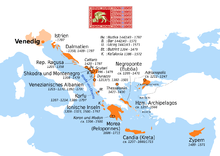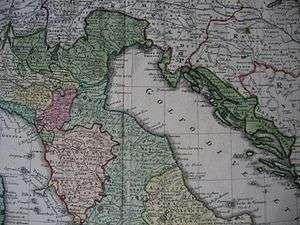Stato da Màr
The Stato da Màr or Domini da Mar ("State/Domains of the Sea") was the name given to the Republic of Venice's maritime and overseas possessions, including Istria, Dalmatia, Albania, Negroponte, the Morea (the "Kingdom of the Morea"), the Aegean islands of the Duchy of the Archipelago, and the islands of Crete (the "Kingdom of Candia") and Cyprus.[1] It was one of the three subdivisions of the Republic of Venice's possessions, the other two being the Dogado, i.e. Venice proper, and the Domini di Terraferma in northern Italy.
| State of the Sea Stato da Màr (vec) | |||||||||||||
|---|---|---|---|---|---|---|---|---|---|---|---|---|---|
| Overseas colonies of the Republic of Venice | |||||||||||||
| 992–1797 | |||||||||||||
 Map of the Venetian colonial empire | |||||||||||||
| Historical era | Middle Ages | ||||||||||||
| 992 | |||||||||||||
• Fourth Crusade | 1202–04 | ||||||||||||
| 1463–79 | |||||||||||||
| 1645–69 | |||||||||||||
| 1684–99 | |||||||||||||
| 1714–18 | |||||||||||||
| 12 May 1797 | |||||||||||||
| |||||||||||||
History
The creation of Venice's overseas empire began around 1000 AD with the conquest of Dalmatia and reached its greatest nominal extent at the conclusion of the Fourth Crusade in 1204, with declaration of the acquisition of three octaves of the Byzantine Empire. However, most of this territory was never controlled by Venice, being held by the Greek Byzantine successor states (the Despot of Epirus, the Empire of Nicaea, and the Empire of Trebizond) and much of the rest was soon lost as the Byzantine Empire of Nicaea reconquered Constantinople in 1261.
The aftermath of the War of Chioggia saw another period of rapid growth of the Venetian empire: the island of Corfu came under Venetian rule in 1386, the fortresses of Argos and Nauplia in 1388 (although Argos did not come under actual Venetian control until 1394) the Aegean islands of Tinos and Mykonos in 1391, the Adriatic ports of Durazzo and Alessio on the Albanian coast in 1392, followed by Scutari in 1396 and Drivasto in 1397.[2] The year 1402 in particular marked a watershed, with the Battle of Ankara temporarily reversing the rise of the Ottoman Empire in the east, and the death of Giangaleazzo Visconti, Duke of Milan, creating a power vacuum in northern Italy. Venice quickly exploited the situation to expand its overseas territories, and also begin its conquest of the Terraferma. In the southern Balkans, the favourable climate created by the Treaty of Gallipoli in 1403 with the Ottomans led to a growth of commerce and the acquisition of a new string of fortresses in Greece: Lepanto in 1407, Patras in 1408, Navarino in 1410, and Thessalonica in 1423.[2]
In Dalmatia, which it had been forced to cede to the Kingdom of Hungary in the Treaty of Turin (1381), the Venetians took advantage the Ottoman civil war and the conflict between Ladislaus of Naples and Sigismund of Hungary over the Hungarian throne, and in 1409 secured the cession by Ladislaus of the cities he controlled—Zara with the island of Cres and Ossero, Arbe, Pag, Laurana, and Novigrad—as well as all his rights to the rest of Dalmatia, for 100,000 ducats.[3]
For many centuries the "Stato da Màr" survived in the Balkans, mainly in the Adriatic sea that was even nicknamed "Mare di Venezia" (sea of Venice) on maps of the seventeenth and eighteenth centuries.
Later on, under increasing pressure from the Ottoman Empire, further residual territories were lost and re-organised until only Istria, Dalmatia, and the Venetian Ionian Islands were left when the Republic fell to Napoleon in 1797.
Domains
- Venetian Istria, including Istria, in modern Croatia
- Venetian Dalmatia, including Dalmatia and minor possessions in the hinterland, in modern Croatia
- Venetian Albania, including Bay of Kotor and minor possessions in the hinterland, in modern Montenegro
- Venetian Ionian Islands, Kingdom of Candia and various other possessions, in modern Greece
- Venetian Cyprus, former Kingdom of Cyprus
Notes
- Map of venetian forts & presence in the Stato da Mar of southern Balkans
- Gullino 1996, § La politica delle annessioni.
- Gullino 1996, § La conquista della Dalmazia (1409-1420).
Bibliography
| Wikimedia Commons has media related to Stato da mar of the Republic of Venice. |
- Arbel, Benjamin (1996). "Colonie d'oltremare". In Alberto Tenenti and Ugo Tucci (eds.). Storia di Venezia. Dalle origini alla caduta della Serenissima. Vol. V: Il Rinascimento. Società ed economia (in Italian). Rome: Enciclopedia Italiana. pp. 947–985. OCLC 644711009.CS1 maint: uses editors parameter (link) CS1 maint: ref=harv (link)
- Crowley, Roger (2011). City of Fortune - How Venice Won and lost a Naval Empire. London: Faber and Faber. ISBN 978-0-571-24594-9.
- Da Mosto, Andrea (1937). L'Archivio di Stato di Venezia. Rome: Biblioteca d'Arte editrice.
- Gullino, Giuseppe (1996). "Le frontiere navali". In Alberto Tenenti and Ugo Tucci (eds.). Storia di Venezia. Dalle origini alla caduta della Serenissima. Vol. IV: Il Rinascimento. Politica e cultura (in Italian). Rome: Enciclopedia Italiana. pp. 13–111. OCLC 644711024.CS1 maint: uses editors parameter (link) CS1 maint: ref=harv (link)
- Mutinelli, Fabio (1851). Lessico Veneto. Venice: tipografia Giambattista Andreola.



